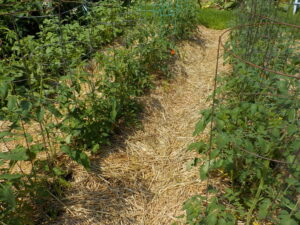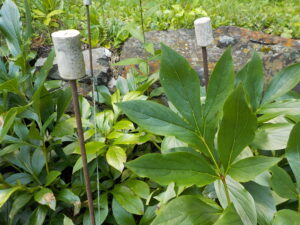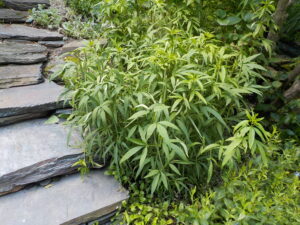July Chores for the Gardener
Posted on Tuesday, July 4, 2023 · Leave a Comment
For me, July has started off wet: rains, heavy at times, three days a week and going on for weeks. Although I like not having to water my new plantings in the vegetable garden and flower beds, some plants are having a tough time- they need sunshine!
It’s fortunate that I make raised beds in my vegetable garden which is near our stream. Hoeing up the earth from the pathways and adding compost has helped me considerably. Even though the beds are only six inches above the walkways, it helps to drain soggy soil. Of course it’s too late to do that if you have already planted on the flat of the garden – but remember for next year, as we may see these conditions again.
If you haven’t thinned your carrots, beets and other root crops yet, now is the time to do so. I try to get that done by July 4th, but later is okay. You can thin to one inch if you want to thin them again to two inches in a few weeks, or you can just thin to two inch spacing now. The advantage to thinning twice is that your carrots will be big enough to eat when you thin them the second time.
Carrots are heavy feeders, so you may want to side-dress the rows with a little slow-release organic fertilizer like Pro-Gro or Espoma Garden Tone. Just sprinkle a thin line of fertilizer alongside the carrots, and then use a hand tool to work it in a little.

Straw placed over newspapers keeps down weeds in my vegetable garden
I recently finished mulching my pathways and around bigger plants like tomatoes. I put down a layer of newspaper – four sheets or more – and cover it with straw. This does a good job of keeping down the weeds. Hay is cheaper, of course, but has seeds which can grow.
For onions, carrots and other things planted close together in straight rows I tear strips of newspapers and cover them with grass clippings or, better still, chopped leaves from last fall. FYI: newspapers rip well from top to bottom, but not across the page.
I did lots of staking of peonies in June, as many of them have such heavy blossoms that they bend over and land on the ground, particularly after a rain. Tall fall asters and goldenrod and even phlox will fall over later on as they get too tall to stand up to rains and wind.

Wine corks placed on tips of iron rods protect me against a poke in the eye when bending over to sniff the peonies
I have lots of 4-foot and 5-foot quarter-inch diameter iron rods I had custom-made for me for holding up these fall beauties. The iron rods go deep into the soil more easily than thin bamboo stakes, and are stronger. To avoid getting poked in the eye when bending over, I put a wine cork on the top of each one. I drill a quarter inch hole into the cork and slide it on. They are a good excuse to buy a nice bottle or French red from time to time with a real cork!
It’s getting late in the season to cut back tall flowers to keep them shorter, but you might try cutting back some phlox or asters now if they haven’t start making flower buds yet. Traditionally this is called the “Chelsea Chop” and is named after the Chelsea Flower Show in London, which occurs in late May each year. After the Chelsea show English gardeners prune back big tall plants. They bloom later, are shorter, and often have many more blossoms. Good candidates for hard pruning include asters, Boltonia, purple cone flower, Joe Pye weed, sneezeweed (Helenium), bee balm, Russian sage, phlox, obedient plant, Rudbeckias of all sorts and Culver’s root.

This tall coreopsis was cut back by half in late June to keep it a manageable size
Not all flowers respond well to the Chelsea Chop. Do not do this with lady’s mantle, columbine, goats beard, astillbe, delphinium, gas plant (Dictamus), fox glove, geraniums, daylilies, hostas, iris, lupines or oriental poppies, among others. You can find lists of which to cut and which to leave alone in Tracy DiSabato-Aust’s fine book, “The Well-Tended Perennial Garden”s. Everyone should have a copy of it.
Weeding flower beds is loved by a few gardeners, but avoided by many. I am so lucky that both my wife Cindy and I like to weed. Cindy is a formidable weeder, even better than me – and she has much more endurance than I do. If you don’t enjoy weeding, set a goal: work for half an hour. Work until this small bed is weed free. Weed every morning or evening for 15 minutes. Small efforts done every day really make a huge difference.
My advice? Get a good weeding tool that you like, one that will get under the roots so that you can lift from below and pull from above. For us, that is the CobraHead weeder (
www.CobraHead.com). It’s made like a curved finger with just a single tine. I can tease out roots that, if broken, would re-sprout. It’s important to get the entire root system out so you don’t have to pull the same weed over and over.
We use ground fall leaves in the flower beds, or lacking enough, we buy double-ground bark mulch. But be careful: if you use too much, you can starve your plants of water from light rains. An inch and a half is what I strive for. Anything less than an inch looks good, but won’t do much to deter weeds. And if there are roots from things like goutweed or Japanese knotweed, no amount of mulch will deter those culprits.





